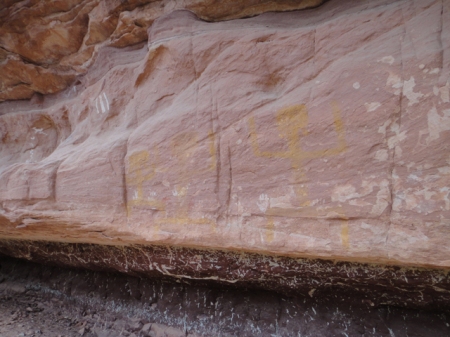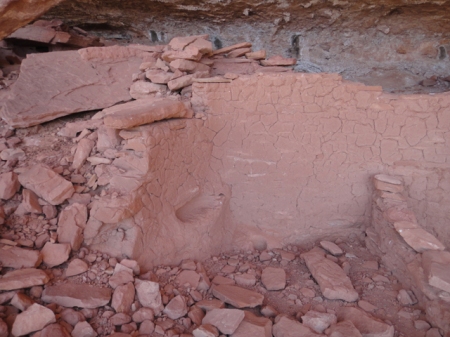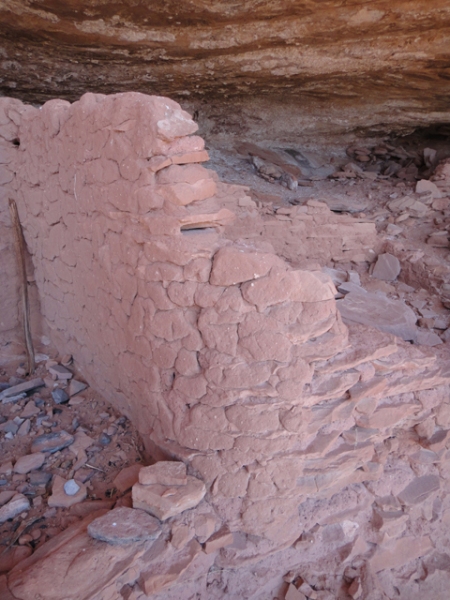We usually make a trip to southern Utah each year later in June, staying into July. This year we planned it so that trip was moved up to late May and into June. It made for more bearable and longer days at Nancy Patterson Village, and easier walking in the canyons later on. Of course there has been another trip since then where we enjoyed temperatures in the high 90’s and low 100’s. We’ve had such a full summer so far there just hasn’t been time to get to a blog post until now.
Nancy Patterson Village
For the third season we spent a couple of weeks at Nancy Patterson Village doing archaeology. We finished the interior excavation of the room where we began in 2014. We have so much data at this point that it may take us into next summer just analysing and writing it all up. It was our assumption that our unit, being on the edge of the village, was late in date. We confirmed this, and we also confirmed our speculation that the room was built over an earlier midden. Our unit was in the eastern-most room of what I would call a patio group. The approximate size of the group is 13 by 13 meters. It is U-shaped, being open on the east side.

Working at Nancy Patterson Village would not be complete without our daily visits from collared lizards. Here a pair watches us from our backdirt pile.
Data collected from throughout the patio group indicate the earliest occupation is centered on the western side, or bottom of the “U”. The latest occupation appears to be our unit, the end room on the northern leg of the “U”. It is likely that the end room opposite us, to the south, is coeval with ours. There are other rooms and room blocks beyond our patio group out in the periphery; isolated rooms, those laid out in a linear fashion, and possibly an L-shaped group. These rooms are all unexcavated and the dates are unknown, but we assume they are closer to the date of our unit which was likely abandoned toward the “very end”, somewhere around the early to mid-1200’s. More about Nancy Patterson will be posted as we continue analysis and writing.
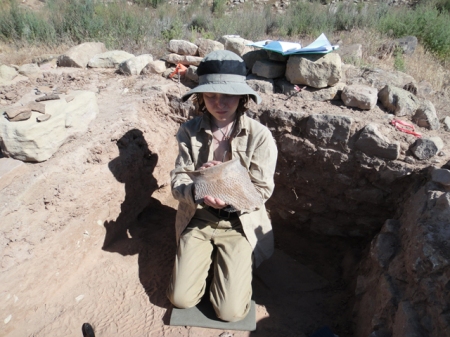
The young archaeologist at work at Nancy Patterson Village with a large Mesa Verde corrugated sherd from a post-abandonment artifact concentration just removed.
Amtrak as Part of Our Adventures
After our time at Nancy Patterson Village we had a few relaxing days at a couple of our favorite camps before Nicolai headed home. For those unfamiliar with the area around Interstate 70 north of Moab, a rail line roughly parallels the highway from Glenwood Canyon in Colorado to just past Green River in Utah, where it turns north toward Salt Lake City. The line is used by freight trains and by Amtrak as well. Since we hadn’t been on the train in a number of years, we decided to use it to get Nicolai back to Colorado. We boarded in Green River at about 8 AM and arrived in Glenwood Springs about noon where we met the missing member of our party (mom gets to hold down the fort when we are off in the bush.) The train ride, if there are no long delays, is scenic and enjoyable. You get to see a lot of country along this four hour stretch, and it’s best seen from the observation car. Unfortunately the trip back to Green River was not as quick nor as enjoyable. Just outside Glenwood Springs the train hit a truck which delayed us for about 4 hours. Believe it or not, the driver of the truck crawled out and walked away. The conductors on the train called it miraculous, and likened the train hitting a truck to a semi truck running over an empty soda can. The lesson- be careful at all railroad crossings, especially those without arms that come down to block traffic.
Grand Gulch
With Nicolai safely back in Colorado I had the next week or so to myself. So it was off to Grand Gulch for some alone time. I hadn’t been in Pine Canyon in some time, so I used it as my entrance. I parked at the drill hole at the end of the road and was in the canyon in no time. It’s a fairly easy walk all around- across the mesa, the climb in, and the walk down to Grand Gulch. I found the canyon very different from the previous trip about 7 weeks before. During our April backpack the canyon bottom was filled with water; we were faced with skirting around pools and hopping across water running down Grand Gulch. This trip, water was barely visible in the bottom of Grand Gulch. There were a few green, debris covered pools here and there that were of course drinkable, but it was like night and day compared with two months before. The weather was warming at this point, and the heat and lack of water ensured that I was the only one in the canyon- I didn’t hear or see anyone on this trip.
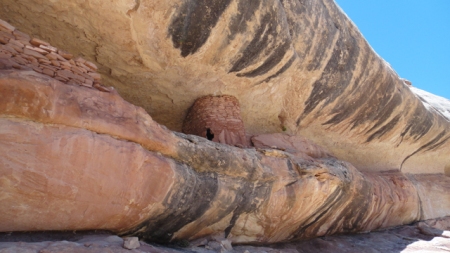
Round ruin in Pine Canyon with very interesting architectural change in structure- due to available materials or aesthetics? Note vertical slabs down low, with regular, coursed masonry above.
I could go on as always, but will save it for another post. Next up- more on our new inReach SE, rock art in a boulder field, and parallel stone alignments leading the way to Spirit Bird Cave. For more on our desert adventures, gear reviews, and our archaeological endeavors, visit the Desert Explorer website.




 Posted by desertexplorer
Posted by desertexplorer 
